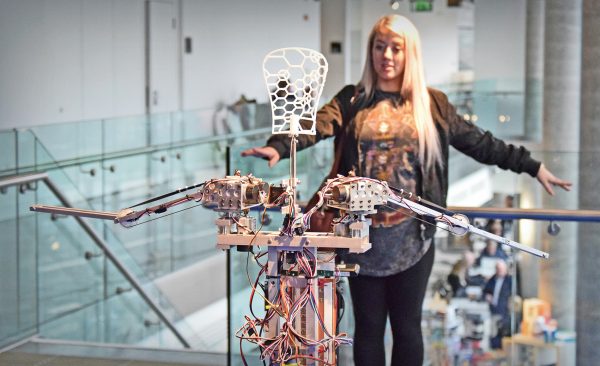
Pictured: A robot arm, one of the installations at the Science Gallery.
Photo by Kevin O’Gorman.
A free exhibition exploring the possibilities of artificial intelligence is currently showing at Trinity College Dublin. Humans Need Not Apply, the spring exhibition at the Science Gallery on Pearse Street opened on February 10th recently, and will run until May 21st, 2017.
Art meets technology to explore the possibilities of what role Artificial Intelligence (AI) will play in the future of humanity. Will sentient robots improve our lives or will they take them over?
According to some of the artists showcased at the exhibition, our destiny may be prosperous but others have a more dystopian view of where our quest for advancement will take us. In a humorous, disturbing and thought-provoking mixture of themes, the Science Gallery has us ask: “Do our iPhones have a brighter future than we do?”
Creativity
We often worry about automated machines taking work from us. It can already be seen happening today if you walk into any McDonald’s or Tesco store, which has decreased its work force by installing self-service devices. But what if artificial intelligence also replaces our value as creators, artists and writers?
Word-Camera, invented by Ross Goodwin, a creative technologist, translates photographs into paragraphs. He explains, “I have been working on it for about two years and reiterating on it. The first version I built in April 2015 was a web app and then I built the physical version inside of an old camera. It uses three different neural networks to narrate an image. This is a device that one day could help you write with a camera rather than a pen.”
Love
Lady Chatterley’s TinderBot is an interactive installation created by Libby Heaney, a lecturer at the Royal College of Art. It explores love in a post-digital age. An artificial intelligence device was programed with the script of D.H Lawrence’s novel and uses phrases solely from the book in reply to Tinder users with hilarious outcomes. The visitor can swipe right or left on a large screen, imitating the Tinder app, to view positive and negative conversations members of the public have had with the machine.
Work
As seen by the numerous films and television series that address the subject, we are fascinated by the prospect of robots in our workplaces and homes. Anna Dumitriu and Alex May, creators of Antisocial Swarm Robots, ask how will we get on living in such close quarters with robots. The installation is a pen, and corralled inside are tiny moving robots that look like insects. They seem to avoid each other and any interactions with the visitor.
May explains, “This piece is about exhibiting robots that are designed to display anti-social behaviour, which people perceive in many different ways, we project our own humanity onto them to understand them. We are trying to figure out if they are happy or sad but of course they are not, they are just robots. This sometimes creates tension or misunderstanding between the human and machine.”
Dumitriu adds, “The question is, if humans have these brains that are constantly trying to read things, and lacking the understanding that we are just dealing with machines here, how are we ever going to live in a workplace or home surrounded by robots if we are misunderstanding everything they do all the time?”
If you have a free hour or two and are curious about an automated future world, there are many more interactive and fun installations to explore at the gallery. Then you can decide for yourself if Artificial Intelligence will be human-led or humanless?
By Jessica Ellis



